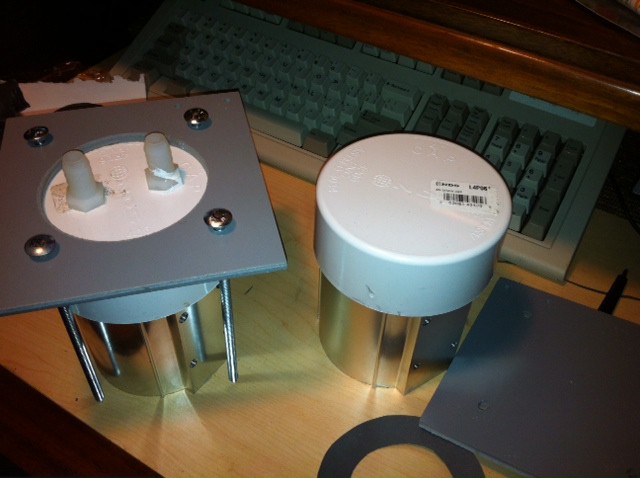-
Microprocessor & Code
08/20/2014 at 23:36 • 0 commentsI am currently using the Arduino ATMEGA 2560 to control the device. There is a momentary switch that initiates a hardware interrupt to reverse the solenoids and provide the simulated pain relief. The water pumps run continually, but are also controlled via the MC. There are several temperature sensors that allow for temperature regulation & etc. I have a float switch to determine when to begin logging data from the device to the web. I have not decided where to log data, yet. My hope would be that a research school would host the data and allow other institutions to contribute. For backup purposes and to allow for conducting tests in areas without reliable web access, I plan to log data to a microSD card. The software I have thus far is very very simple. I have uploaded code to BitBucket and plan to make it available, as soon as I do a better job with commenting the code and explaining some potential use-cases.
-
Hot & Cold Water Device
08/20/2014 at 22:51 • 0 commentsOne issue with the original design was that it required ice water and hot water from an external source to work. I have designed a device that I hope will solve the logistical problems involved in replicating experiments that way by using multiple Peltier coolers to both heat and cool the water to acceptable temperatures. I scavenged parts from two wine chillers to make the bulk of this device. Current draw should be somewhere just below 12 amps at 12 volts, so I will need to be upgrading my power supply!
My hope is that I can achieve an adequate difference in temperatures quickly enough to be able to conduct one test per half hour. We will see!
-
Problems along the way.
08/13/2014 at 17:43 • 0 commentsSo, I have tried several combinations of solenoid valves and finally settled on 12v DC gravity type valves. They require very low pressure to activate, as opposed to sprinkler and even other allegedly "low-pressure" valves. The Iwaki impeller type pumps that I am using do not supply enough pressure in this system to activate anything but the gravity type solenoids. Not a big deal, but I would have saved some money had I done a little bit of homework and read the specs on the other solenoids. My bad.
Initially the system used ice cubes and hot water from a tap to provide the hot and cold water needed for the test. This works, but it is less easy to control temperature as a variable and it requires ice cubes and hot water access for repeated tests. I am scavenging some wine chillers for their Peltier devices and aluminum carafes. I hope to take advantage of these to more systematically control the hot and cold water.
I drilled holes in threaded plugs for the temperature sensors. I simply epoxy in the sensor and voila! This seems to work just fine, but I have placed epoxy on the outside of the plug and it tends to be too thin in spots and flake off. I believe it to be cosmetic only, but who doesn't want their pain-inducing medical device to be as pretty as possible? I will be looking for a solution to this.
I purchased pipe fittings from a variety of sources and have found some significant quality differences along the way. Some, but not all, of the less expensive fittings require a much tighter fit to not leak. Some leak, regardless of the hose clamp tightness. This isn't a big deal, but I would be careful when sourcing parts, if I were planning to build many of these.
As far as hose clamps go, the automotive style clamps really seem to work well compared to plastic type clamps. They are around $1 each at the local auto parts store, but have seemed to be worth the expense.
Hope this provides you with some visibility to some of the obstacles that I have encountered!
-
In the beginning.
08/13/2014 at 15:21 • 0 commentsI began by constructing the water chambers from PVC pipe. It is very easy to work with and relatively inexpensive. I found that I needed to buy an automotive tap and die set, so I could add smaller fittings for the hose connections and sensors.
There are two chambers; one is for cold water where you place your hand and the other is for hot water. The premise here is that you place your hand into the cold water far enough for the water level rise to trigger a float switch and begin data logging. While there are several different options for data collection beyond that point, the initial plan is for you to press a button as you experience different levels of pain. When you can't handle the pain anymore, a hardware interrupt associated with the switch will reverse the flow of water (using solenoid valves) and flood the cold water chamber with hot water. It really feels quite pleasant! This is intended to simulate the effect of a pleasure or euphoric kind of pain reliever.
You may vary the time between the subject's pressing the pain relief button and the system's actual deliver of relief to study how perceived or actual delays in pain relief might contribute to the subject's subsequent self medication. There are many other ways to vary the program in order to advance our knowledge of pain using the pain machine. Incidentally, I think we need a much cooler name than "Pain Machine". Any ideas are welcome in the comments!
Pain Machine
An apparatus to assist in the study and collection of data on the subject of pain.
 Scott
Scott